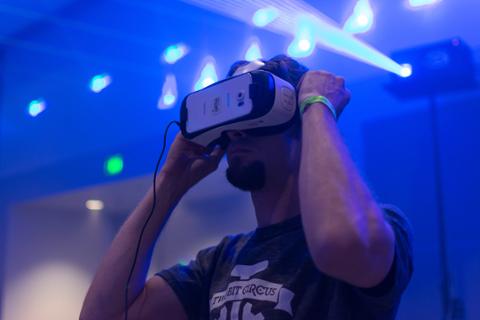
According to
new estimates by research firm IDC, worldwide revenues for the augmented reality (AR) and virtual reality (VR) market will grow from $5.2 billion in 2016 to more than $162 billion by 2020. With that revenue growth comes jobs—potentially lots of jobs. Although employers usually advertise for experienced pros, most hiring managers are willing to consider people with non-AR/VR backgrounds who demonstrate an interest and aptitude for careers in this burgeoning field. “We’re starting to see the gold rush,” said Ron Fosner, director of emerging technologies for Stardock, who points out that Sony sold nearly one million PlayStation VR units after just a few months on the market. Meanwhile, industry watchers are starting to see VR expand beyond gaming into verticals such as architecture, real estate, healthcare, retail and industrial training. If you’re trying to break into this industry with limited experience, you’ll need some training, as well as familiarity with the relevant hardware and software.
Find Your Niche
Getting to know the right
hardware should be your first step. “Figure out what the VR experience is,” Fosner advised. Getting a sense for how VR headsets such as the Oculus, HTC Vive or HoloLens interoperate with laptops and controllers is key, because not every designer or developer has the visual skills and depth perception to effectively integrate AR/VR-centric functions such as head tracking and hand movements into an app; knowing these things will truly allow you to stand out. Because many of the traditional UI tools and elements simply won’t work in VR, even experienced pros may need additional training to succeed in the VR space. If you have the visual skills, the next step is to figure out which roles provide a stepping-stone or ideal entry point to a position. For instance, professionals with experience in Java web development or 3D modeling software (the latter used in building visual assets for movies and animation) tend to have the easiest time transitioning to AR/VR, according to Megan Gray, HR manager for Marxent. And if you already know how to program in C#, Java, Swift or Android, learning
Unity is the next step, as many AR and VR platforms rely on it to power games and apps. (And since updating gaming software is complex, employers are always on the lookout for web developers who have experience with content management systems.) Transitioning into a non-technical role in project management or QA is also a good way to break into AR/VR, Gray noted, especially if you have a CS background. Once you’re on the inside, it’s fairly easy to build up your experience and level of responsibility. In fact, one of Marxent’s employees, after starting out with an associate’s degree in digital art, acquired enough on-the-job experience to move into engineering.
Build Something
Want to really grab a hiring manager’s attention? Commit to working on an AR/VR project and finishing it. Create Unity code samples that you post on GitHub, or
build a simple demo game and showcase your efforts on your website, YouTube, or Facebook. “It doesn’t necessarily have to be complicated or perfect,” Gray said. “Managers simply want to see if you’ve acquired the skills and know how to apply them.” Fosner views the completion of a side project as a sign of passion and potential. Since most people don’t have an extensive background in VR, he looks for self-driven professionals who have gone the extra mile to gain experience on their own time.
Make Connections
Hang out with the people who are already working in the industry. “These folks are your intellectual stimulation,” Fosner said. “They know stuff; take the opportunity to learn from them.” Go to meetups and conferences, or participate in
hackathons. Don’t be afraid to email a hiring manager and invite them to discuss your career aspirations over coffee. People who work in VR are passionate about the space and their creations. They are usually willing to talk shop with professionals who are looking to transition into this rapidly evolving field.
 According to new estimates by research firm IDC, worldwide revenues for the augmented reality (AR) and virtual reality (VR) market will grow from $5.2 billion in 2016 to more than $162 billion by 2020. With that revenue growth comes jobs—potentially lots of jobs. Although employers usually advertise for experienced pros, most hiring managers are willing to consider people with non-AR/VR backgrounds who demonstrate an interest and aptitude for careers in this burgeoning field. “We’re starting to see the gold rush,” said Ron Fosner, director of emerging technologies for Stardock, who points out that Sony sold nearly one million PlayStation VR units after just a few months on the market. Meanwhile, industry watchers are starting to see VR expand beyond gaming into verticals such as architecture, real estate, healthcare, retail and industrial training. If you’re trying to break into this industry with limited experience, you’ll need some training, as well as familiarity with the relevant hardware and software.
According to new estimates by research firm IDC, worldwide revenues for the augmented reality (AR) and virtual reality (VR) market will grow from $5.2 billion in 2016 to more than $162 billion by 2020. With that revenue growth comes jobs—potentially lots of jobs. Although employers usually advertise for experienced pros, most hiring managers are willing to consider people with non-AR/VR backgrounds who demonstrate an interest and aptitude for careers in this burgeoning field. “We’re starting to see the gold rush,” said Ron Fosner, director of emerging technologies for Stardock, who points out that Sony sold nearly one million PlayStation VR units after just a few months on the market. Meanwhile, industry watchers are starting to see VR expand beyond gaming into verticals such as architecture, real estate, healthcare, retail and industrial training. If you’re trying to break into this industry with limited experience, you’ll need some training, as well as familiarity with the relevant hardware and software.
 According to new estimates by research firm IDC, worldwide revenues for the augmented reality (AR) and virtual reality (VR) market will grow from $5.2 billion in 2016 to more than $162 billion by 2020. With that revenue growth comes jobs—potentially lots of jobs. Although employers usually advertise for experienced pros, most hiring managers are willing to consider people with non-AR/VR backgrounds who demonstrate an interest and aptitude for careers in this burgeoning field. “We’re starting to see the gold rush,” said Ron Fosner, director of emerging technologies for Stardock, who points out that Sony sold nearly one million PlayStation VR units after just a few months on the market. Meanwhile, industry watchers are starting to see VR expand beyond gaming into verticals such as architecture, real estate, healthcare, retail and industrial training. If you’re trying to break into this industry with limited experience, you’ll need some training, as well as familiarity with the relevant hardware and software.
According to new estimates by research firm IDC, worldwide revenues for the augmented reality (AR) and virtual reality (VR) market will grow from $5.2 billion in 2016 to more than $162 billion by 2020. With that revenue growth comes jobs—potentially lots of jobs. Although employers usually advertise for experienced pros, most hiring managers are willing to consider people with non-AR/VR backgrounds who demonstrate an interest and aptitude for careers in this burgeoning field. “We’re starting to see the gold rush,” said Ron Fosner, director of emerging technologies for Stardock, who points out that Sony sold nearly one million PlayStation VR units after just a few months on the market. Meanwhile, industry watchers are starting to see VR expand beyond gaming into verticals such as architecture, real estate, healthcare, retail and industrial training. If you’re trying to break into this industry with limited experience, you’ll need some training, as well as familiarity with the relevant hardware and software.


